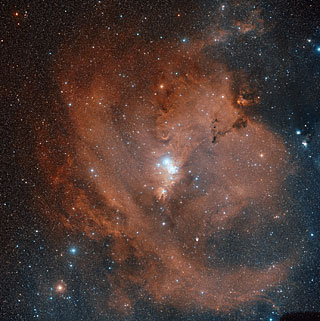The Cone Nebula
The origin of the mysterious cone-shaped region seen on the center remains a mystery. The interstellar formation, dubbed the Cone Nebula, is located about 2700 light years away. Other features in the image include red emission from diffuse interstellar hydrogen, wispy filaments of dark dust, and bright star S Monocerotis. Blue reflection nebulae surround the brighter stars visible on the center. The dark Cone Nebula region clearly contains much dust which blocks light from the emission nebula and open cluster NGC 2264 behind it. One hypothesis holds that the Cone Nebula is formed by wind particles from an energetic source blowing past the Bok Globule at the head of the cone. (Text adapted from Astronomy Picture of the Day). This image is a composite from black and white images taken with the Palomar Observatory's 48-inch (1.2-meter) Samuel Oschin Telescope as a part of the second National Geographic Palomar Observatory Sky Survey (POSS II). The images were recorded on two glass photographic plates - one sensitive to red light and the other to blue and later they were digitized. Credit: Caltech, Palomar Observatory, Digitized Sky Survey. In order to produce the color image seen here, I worked with a total of 50 different frames, 25 for each color band, coming from 2 different plates taken between 1989 and 1992. Original file is 16,840x16,870 pixels with a resolution of about 1 arcsec per pixel. The image show an area of sky large 4.7ø x 4.7ø (for comparison, the full-Moon is about 0.5ø in diameter).
This fits liberator image is not available for sale.
Credit:About the FITS Image
| Id: | davidedemartin_9 |
| Name: | Davide De Martin |
| City: | Venezia |
| Country: | Italy |
